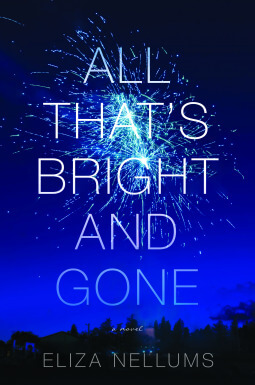

I had the opportunity to connect with Eliza Nellums, the author of All that’s Bright and Gone that was released this week (available December 10, 2019 to be specific). Written mostly through the eyes of little Aoife with some narration in the form of letters from her mom, All that’s Bright and Gone is a story about believing in what parents tell us and doing the best a child can to see her guardian again. I already shared my thoughts about the book with you (book thoughts link) and now it’s time to talk to Eliza herself.
Eliza is a member of Bethesda Writer’s Center as well as the Metro Wriders, a weekly critique group that meets in Dupont Circle. All that’s Bright and Gone is her debut novel. She lives in Washington DC. It was wonderful to connect with her! Enjoy the interview, and get some insights about the book, without any spoilers! 🙂
- What was the moment when the idea of the book first came to be?
I remember being astonished by my sister’s children, by how much personality and force of will they had at such a young age. I mean, even younger than Aoife, I think they were probably like one or two years old when I was noticing this. They had inner lives and dreams and goals of their own already. And that’s what I wanted to write about.
- Did you bring some of your own life experiences in All that’s Bright and Gone, through Aoife, Siobhan and Uncle Donny?
I did mine my own childhood trying to remember how I experienced the world at age six. I actually had a diary that I started around that age (the early entries were not very complex!). My family situation was much, much better than Aoife’s, I have to say. I think I probably channeled myself when I was writing Uncle Donny the most, because I don’t have children myself, and I’m very familiar with that sense of panic when you are asked to step – however briefly – into the role of adult, and you don’t know that you’re going to be very good at it, and you’re not sure where the boundaries are.
- When a person is first introduced to Aoife, she tells the reader what kind of animal this person is like. How does Aoife see people as animals?
That was fun to write! Children are often fixated on animals so this seemed like a convenient way to get some descriptive information across, since it didn’t seem realistic for Aoife to be describing people in a lot of detail.
- Did you have an active imagination growing up? Sioban did not like Aoife talking to Teddy out loud and Hannah makes fun of Aoife at one point in the novel for this. What are some ways one can encourage kids to pursue their active imagination? How can adults be more accepting of this?
I still have a pretty active imagination, haha. But I don’t think I was ever legitimately confused about the boundaries of what was real, like Aoife is. I suspect the best way for kids to develop empathy and imagination is to read widely, especially books by diverse or marginalized writers. Adults could benefit from the same thing! Maybe we can all work on it together. I know that’s my goal for the coming year.
- If readers could take one thing away from this book, what would you want it to be?
We lie to children thinking we’ll protect them, but they will reach their own conclusions if we don’t help them understand the truth.
- What was the hardest part about writing this book? What research did you have to pursue to write this novel?
The character of Doctor Pearlman – I’m not a child psychologist, so I was worried about being accurate about the kinds of questions she would ask Aoife, or the way she would approach a case like this. I do have a friend who is a counselor and works with kids, so I peppered her with questions – but I’m still not sure it’s quite right!
- What would you recommend your readers to read after All That’s Bright and Gone?
So many! And probably other examples I’m forgetting. Room by Emma Donoghue, The Curious Incident of the Dog in the Night-Time by Mark Haddon, The Lovely Bones by Alice Sebold, The Sweetness at the Bottom of the Pie by Alan Bradley and My Grandmother Told Me To Tell You She’s Sorry by Fredrik Backman would all be good places to start.
- What would you tell your younger self when it comes to writing?
Just keep having fun for as long as you can. It’s hard not to rush, not to want to hit the big time as fast as you can. But you don’t want to get there with a book that isn’t ready – and someday you’ll miss the days when you were writing just for yourself, without worrying what anybody else will think.
I hope you enjoyed this Q&A with Eliza! You can connect with her in the following ways.
** All that’s Bright and Gone is now out in stores so get a copy and let me know what you think! My book thoughts can be found here.**
Amazon Print
Amazon Kindle
Do come back tomorrow because I’ll be sharing the Q&A that Ariel and I conducted with Joanne Ramos, author of The Farm.
Cover image: Photo by Ray Hennessy on Unsplash

Be First to Comment